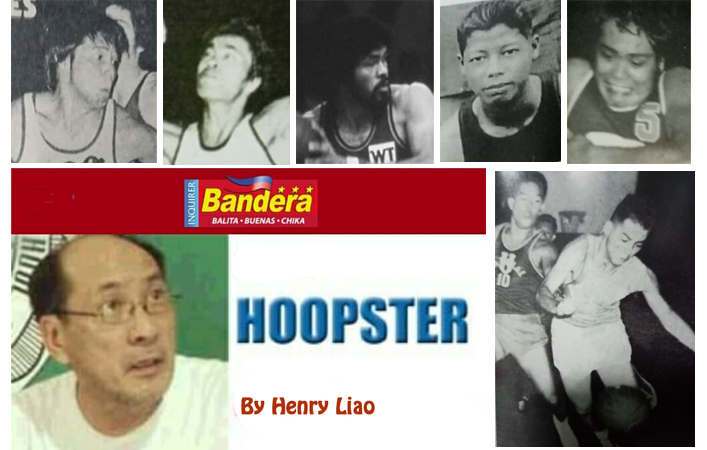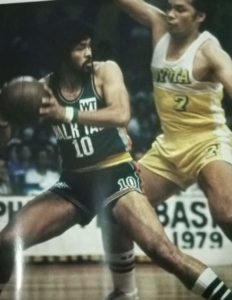
THE game being the national pastime of many Filipinos, it is no small wonder that there have been many prominent athletes in local basketball history, whether it be in the collegiate, amateur/professional ranks or international competitions, since the sport was invented by Canadian James Naismith in Springfield, Massachusetts in December 1898.
With the community home quarantine throughout Metro Manila and Luzon in effect since March 15, we simply have had so much time to do some research on the subject.
Join me then in this test of wits to find the identity of some of the prominent Filipino roundballers from the past.
THE QUIZ PART 2
11. “The Beard” of local basketball came along even before a certain baller by the name of James Harden made the headlines in the NBA.
A member of the gold medal-winning Philippine team in the 1974 Asian Youth Basketball Championship held in Manila, this soft-spoken 6-1 forward out of Mapua Tech, who would patiently comb his trademark beard in the locker room before each game, was the master of the banking jumpers and acrobatic undergoal stabs as the Third Wheel to William (Bogs) Adornado and Fortunato (Atoy) Co Jr. with the Crispa Redmanizers at the start of the PBA in 1975.
But this Sampaloc-born came to his own in 1977 when Adornado went down with a knee injury. That season, he gained MVP honors in the pro league.
This guy played 16 seasons (1975-90) in the PBA with Crispa, Tanduay, Purefoods, Shell and Anejo. During the time, he romped away with 16 conference titles – second only to Ramon Fernandez (20) for most championships in PBA history – in 26 trips to the finals. Who is he? His initials are AH.

12. After being beaten in a pair of tournaments, including the MICAA All-Filipino wars, the Crispa Redmanizers salvaged their 1973 season with a victory in the MICAA Invitational tournament.
There were top guns Fortunato Co and William Adornado, stratospheric Ed Carvajal, shooter Rey Pages (No. 16), shifty Rudy Soriano and pesky guard Reynaldo Franco (No. 19) under head coach Virgilio (Baby) Dalupan.
And then there was a boy-next-door player with the matinee-idol looks who reached national consciousness as an Ateneo de Manila shooter in the NCAA during the late 1960s.
A southpaw with great shooting skills, this 5-8 shooting ace played with the Blue Eagles from 1967 to 1970. He was the King Blue Eagle when Ateneo captured the 1969 NCAA crown.
Past his collegiate stint, he only played in the old MICAA with Crispa and did not make it to the PBA. Instead, he entered the banking industry, rising to become the vice president of China Banking Corporation. What is his name? His initials are LA.
13. With his remarkable offensive prowess, this former King Tamaraw at Far Eastern University made the collegiate headlines after earning MVP honors in the UAAP in the early 1970s.
The high-scoring 6-2 forward-guard was recruited to play for Yco in the commercial MICAA ranks but his limited playing time with the Painters deflated his confidence.
The scoring explosiveness he once owned was gone when he entered the PBA in 1975. He lasted seven seasons (1975-82) and averaged just 10.2 points in 198 games as various injuries and poor conditioning took their toll. What is his name? His initials are VDLS.
14. This bulky 6-foot forward out of the University of the Visayas was one of the topnotch athletes from Cebu who made waves in the Big City that is Manila in the 1970s.
A prolific scorer with his outside shooting, he suited up in the 1970 Asian Youth tournament in Seoul, South Korea where the Philippines grabbed the gold medal.
This fella played in the old MICAA with San Miguel then joined the PBA in its inaugural campaign in 1975, donning the colors of four teams – Royal Tru-Orange, Toyota, Great Taste and Galerie Dominique – in eight seasons (1975-82) with a career 19.7-point average in 289 games. To date, he owns the second-highest scoring clip by a homegrown player in PBA history.
He eventually migrated to San Francisco, California in the U.S. after his roundball career was over. Who is he? His initials are EE.
15. This ambidextrous three-time Olympian (1948 London, 1952 Helsinki and 1956 Melbourne) matriculated at De La Salle College, where he helped the Green Archers to the NCAA crown once, and the University of Santo Tomas, where he led the then-Glowing Goldies to the 1946 and 1947 UAAP titles after World War II.
The shifty 5-10 forward then furthered studies at Columbia University, where he played for the school’s varsity team. A deadly point-producer with his one-handed flips, the Iloilo native is the first Filipino roundballer to play for an America university or college. He later played for Yco in the post-graduate MICAA ranks. What is his name? His initials are RC.
16. Sugbu produced one of its finest athletes in this high-leaping 6-2 center from the University of the Visayas.
The bull-strong native of Naga, Cebu was the original Chairman of the Boards back in the 1970s with his knack of corraling the rebounds with one hand.
This tough hombre starred for San Miguel in the old MICAA and donned the national team colors thrice (1972 Munich Olympics, 1973 ABC tournament and 1974 World Basketball Championship). He started his 12-year PBA tenure (1975-86) with SMC’s Royal Tru-Orange. He created quite a stir when he became the first player ever to command a megabucks contract in the league when he secured a P8,000 monthly salary from Great Taste in 1977, triggering the league to impose a salary cap for the first time.
At San Miguel, this sturdy warrior was earning only P3, 000 a month. In contrast, the top players from Crispa and Toyota were bankrolling P4,000 monthly. What is his name? His initials are MP.
17. This long-armed two-time Olympian (1968 Mexico and 1972 Munich) was known for his physical defense. However, with his mid-1960s/1970s MICAA club team, the Yutivo Opels, this 6-2 guard-center was their heart and soul, working hard on both ends of the floor.
He did not back down from anybody. His leech-like defense against legendary South Korean hotshot Shin Dong Pa during the 1973 ABC tournament in Manila played a crucial role in the Philippines’ victory over the Sokors in the finals. In the photo, this fella (No. 5) battles Crispa’s twin imports Paul Scranton and Tom Cowart in MICAA action. What is his name? His initials are RM.
18. This burly player made it to the 1968 Mexico Olympics as the Philippine team skipper. In photo, the 6-2 slotman goes up for a shot against his Panamanian defender during the Mexico Olympiad as teammates Adriano Papa Jr. (No. 13) and Orly Bauzon (No. 9) look on.
Panama beat PH, 95-92. What is the name of this big boy? His initials are AR.
19. This 6-foot product of Colegio de San Juan de Letran manned the slot for the Knights during the 1974 NCAA season, even challenging La Salle’s Lim Eng Beng for the NCAA MVP race while averaging more than 20 points an outing.
But he never panned out as he did not even play in the professional league PBA.
In NCAA action photo, he looks to score off La Salle big man William (Billy) Johnston (No. 18) while the latter’s teammate Peter Ley (No. 11) looks on. What is his name? His initials are HP.
20. The Philippine basketball team grabbed a third straight title during the 1927 Far Eastern Games in Shanghai, China, defeating the hosts, 27-25, in the gold-medal game.
This all-time great from the old era scored the winning goal.
Who is he?
Clue: His initials are MF
* * * * *
The answers: 11-Afredo (Freddie) Hubalde; 12-Luis (Chito) Afable Jr; 13-Valeriano (Botchok) De Los Santos; 14-Ernesto (Estoy) Estrada; 15-Ramoncito Campos; 16-Manuel (Manny) Paner; 17-Rogelio (Tembong) Melencio; 18-Alberto (Big Boy) Reynoso; 19-Herminio Perete; and 20-Mariano Filomeno.

